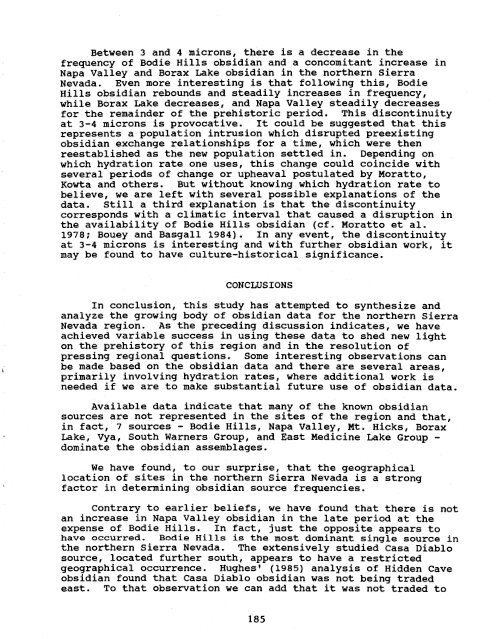regional prehistory and california-great basin - Society for California ...
regional prehistory and california-great basin - Society for California ...
regional prehistory and california-great basin - Society for California ...
Create successful ePaper yourself
Turn your PDF publications into a flip-book with our unique Google optimized e-Paper software.
Between 3 <strong>and</strong> 4 microns, there is a decrease in the<br />
frequency of Bodie Hills obsidian <strong>and</strong> a concomitant increase in<br />
Napa Valley <strong>and</strong> Borax Lake obsidian in the northern Sierra<br />
Nevada. Even more interesting is that following this, Bodie<br />
Hills obsidian rebounds <strong>and</strong> steadily increases in frequency,<br />
while Borax Lake decreases, <strong>and</strong> Napa Valley steadily decreases<br />
<strong>for</strong> the remainder of the prehistoric period. This discontinuity<br />
at 3-4 microns is provocative. It could be suggested that this<br />
represents a population intrusion which disrupted preexisting<br />
obsidian exchange relationships <strong>for</strong> a time, which were then<br />
reestablished as the new population settled in. Depending on<br />
which hydration rate one uses, this change could coincide with<br />
several periods of change or upheaval postulated by Moratto,<br />
Kowta <strong>and</strong> others. But without knowing which hydration rate to<br />
believe, we are left with several possible explanations of the<br />
data. Still a third explanation is that the discontinuity<br />
corresponds with a climatic interval that caused a disruption in<br />
the availability of Bodie Hills obsidian (cf. Moratto et al.<br />
1978; Bouey <strong>and</strong> Basgall 1984). In any event, the discontinuity<br />
at 3-4 microns is interesting <strong>and</strong> with further obsidian work, it<br />
may be found to have culture-historical significance.<br />
CONCLUSIONS<br />
In conclusion, this study has attempted to synthesize <strong>and</strong><br />
analyze the growing body of obsidian data <strong>for</strong> the northern Sierra<br />
Nevada region. As the preceding discussion indicates, we have<br />
achieved variable success in using these data to shed new light<br />
on the <strong>prehistory</strong> of this region <strong>and</strong> in the resolution of<br />
pressing <strong>regional</strong> questions. Some interesting observations can<br />
be made based on the obsidian data <strong>and</strong> there are several areas,<br />
primarily involving hydration rates, where additional work is<br />
needed if we are to make substantial future use of obsidian data.<br />
Available data indicate that many of the known obsidian<br />
sources are not represented in the sites of the region <strong>and</strong> that,<br />
in fact, 7 sources - Bodie Hills, Napa Valley, Mt. Hicks, Borax<br />
Lake, Vya, South Warners Group, <strong>and</strong> East Medicine Lake Group<br />
dominate the obsidian assemblages.<br />
We have found, to our surprise, that the geographical<br />
location of sites in the northern Sierra Nevada is a strong<br />
factor in determining obsidian source frequencies.<br />
Contrary to earlier beliefs, we have found that there is not<br />
an increase in Napa Valley obsidian in the late period at the<br />
expense of Bodie Hills. In fact, just the opposite appears to<br />
have occurred. Bodie Hills is the most dominant single source in<br />
the northern Sierra Nevada. The extensively studied Casa Diablo<br />
source, located further south, appears to have a restricted<br />
geographical occurrence. Hughes' (1985) analysis of Hidden Cave<br />
obsidian found that Casa Diablo obsidian was not being traded<br />
east. To that observation we can add that it was not traded to<br />
185
















